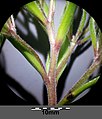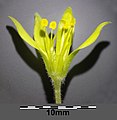Field yellow star
| Field yellow star | ||||||||||||
|---|---|---|---|---|---|---|---|---|---|---|---|---|

Field yellow star ( Gagea villosa ) |
||||||||||||
| Systematics | ||||||||||||
|
||||||||||||
| Scientific name | ||||||||||||
| Gagea villosa | ||||||||||||
| ( M.Bieb. ) Duby |
The gagea villosa ( Gagea villosa ), also arable Gold Star called, is a plant from the genus of the yellow star ( Gagea ) in the family of Liliaceae (Liliaceae). As a common name also is Erdmalz occupied.
description
Vegetative characteristics
The Acker-Gelbstern is a perennial herbaceous plant and reaches heights of 8 to 15 centimeters. It has two basal leaves that are up to 4 millimeters wide and flat, linear, often almost thread-like. The leaf cross-section is mostly only flat on the upper side (in contrast to the meadow yellow star ).
Generative characteristics
The field yellow star blooms in early spring - usually a few days before the meadow yellow star . In Central Europe, the field yellow star usually begins to bloom in mid-March to mid-April. The stem bears two almost opposite bracts, near the umbel-like inflorescence with often more than ten flowers. The flower stalk, the bracts and the style are slightly hairy; hence the specific epithet villosa . The hermaphrodite flowers are smaller than 4 centimeters. The up to ten sulfur-yellow tepals become pointed towards the end.
The number of chromosomes is 2n = 48.
Growth habit and pollination
The Acker-Yellowstar is a geophyte . Its pre-female flowers are pollinated by insects .
Occurrence and endangerment
The distribution of the field yellow star extends over central , northern , eastern and southern Europe as well as to northern Africa and western Asia .
In Central Europe, the Acker-Gelbstern can be found sociable in fields, at the edges of fields, in vineyards and on pasture grassland in gaps. The Acker-Yellowern thrives best in nutrient-rich, loose soils and tolerates both lime-rich and extremely lime-poor bases. It grows especially on sandy or stony fields in climatically favored areas. In the mountains it hardly rises to altitudes of 1500 meters. After Ellenberg the field Yellow Star is a heat pointer, intermediate continental spread, moderately nitrogen-rich locations preferring and Trim characteristic species nutritious agricultural and garden Beikrautfluren (Polygono-Chenopodietalia). In these corridors it particularly likes to thrive in the Setario-Galinsogetum or the Geranio-Allietum. It is often found in the eaves area or at the foot of older trees.
With the use of chemical weed killers , the field yellow star has been displaced almost everywhere from such cultivated land. If at all, it still comes through here on the border of the arable land against poor lawns or in special crops that do not allow weed eradication on the basis of growth substances.
In Germany, the field yellow star is rarely found, in the south this plant species is more common than in the north. This species is endangered in Germany and is on the red list of endangered plant species in category 3 = endangered.
In Austria, the Acker-Gelbstern occurs frequently to absent -mindedly in the Pannonian region , otherwise rarely. The deposits extend to the federal states of Vienna , Lower Austria , Burgenland and Styria .
Individual evidence
- ^ Georg August Pritzel , Carl Jessen : The German folk names of plants. New contribution to the German linguistic treasure. Philipp Cohen, Hannover 1882, page 156. ( online ).
- ^ A b c Manfred A. Fischer, Karl Oswald, Wolfgang Adler: Excursion flora for Austria, Liechtenstein and South Tyrol . 3rd, improved edition. Province of Upper Austria, Biology Center of the Upper Austrian State Museums, Linz 2008, ISBN 978-3-85474-187-9 , p. 1035 .
- ↑ a b Erich Oberdorfer : Plant-sociological excursion flora for Germany and neighboring areas . With the collaboration of Angelika Schwabe and Theo Müller. 8th, heavily revised and expanded edition. Eugen Ulmer, Stuttgart (Hohenheim) 2001, ISBN 3-8001-3131-5 , pp. 124 .
- ^ Gagea villosa in the Germplasm Resources Information Network (GRIN), USDA , ARS , National Genetic Resources Program. National Germplasm Resources Laboratory, Beltsville, Maryland.
- ↑ Entry at Euro + Med
literature
- Erich Oberdorfer : Plant-sociological excursion flora for Germany and neighboring areas . With the collaboration of Angelika Schwabe and Theo Müller. 8th, heavily revised and expanded edition. Eugen Ulmer, Stuttgart (Hohenheim) 2001, ISBN 3-8001-3131-5 .
- Dietmar Aichele, Heinz-Werner Schwegler: The flowering plants of Central Europe . 2nd Edition. tape 5 : Swan flowers to duckweed plants . Franckh-Kosmos, Stuttgart 2000, ISBN 3-440-08048-X .
- Siegmund Seybold (Ed.): Schmeil-Fitschen. Interactive flora of Germany. Seeing - determining - knowing. The key to the flora . CD-ROM, version 2.0. Quelle & Meyer, Wiebelsheim 2004, ISBN 3-494-01368-3 .
- Heinz Ellenberg : Vegetation of Central Europe with the Alps in an ecological, dynamic and historical perspective (= UTB for science. Large series . Volume 8104 ). 5th, heavily changed and improved edition. Eugen Ulmer, Stuttgart (Hohenheim) 1996, ISBN 3-8252-8104-3 .
- U. Raabe: Gold star deposits in cemeteries in the eastern Münsterland. in Göttinger Florist Rundbriefe , Volume 15, Issue 4 Göttingen, 1981, pp. 77-82.
- Werner Rothmaler (founder), Eckehart J. Jäger, Klaus Werner (ed.): Exkursionsflora von Deutschland Volume 4 Vascular Plants - Critical Volume , 10th Edition, Spectrum Academic Publishing House 2005, ISBN 3827416000 .
Web links
- Gagea villosa (M. Bieb.) Sweet, Acker-Goldstern. In: FloraWeb.de.
- Field yellow star . In: BiolFlor, the database of biological-ecological characteristics of the flora of Germany.
- Profile and distribution map for Bavaria . In: Botanical Information Hub of Bavaria .
- Gagea villosa (M. Bieb.) Sweet In: Info Flora , the national data and information center for Swiss flora .
- Datasheet with distribution in the Netherlands. (Dutch)
- Distribution in the northern hemisphere
- Thomas Meyer: Data sheet with identification key and photos at Flora-de: Flora von Deutschland (old name of the website: Flowers in Swabia ).







